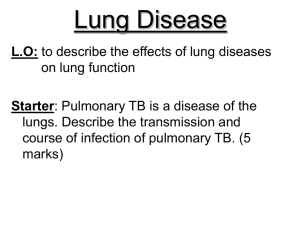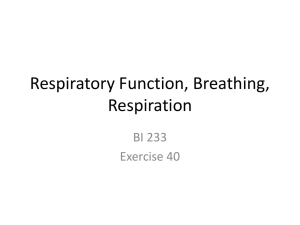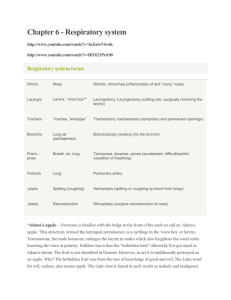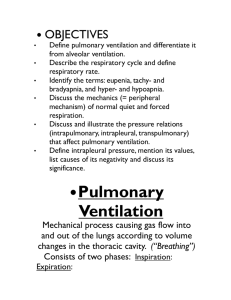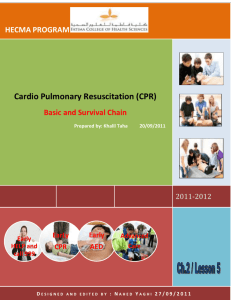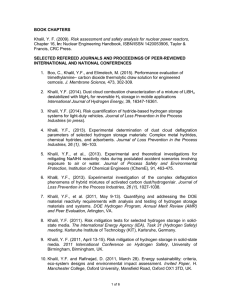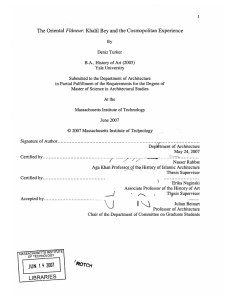Cardio Pulmonary Resuscitation (CPR)
advertisement
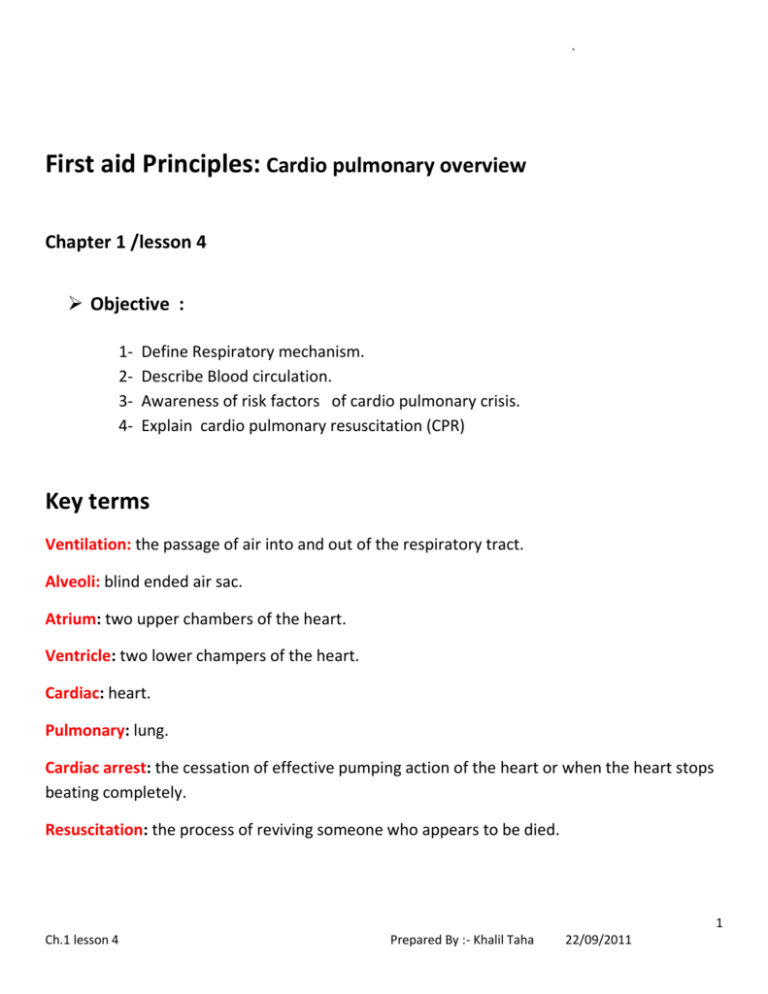
` First aid Principles: Cardio pulmonary overview Chapter 1 /lesson 4 Objective : 1234- Define Respiratory mechanism. Describe Blood circulation. Awareness of risk factors of cardio pulmonary crisis. Explain cardio pulmonary resuscitation (CPR) Key terms Ventilation: the passage of air into and out of the respiratory tract. Alveoli: blind ended air sac. Atrium: two upper chambers of the heart. Ventricle: two lower champers of the heart. Cardiac: heart. Pulmonary: lung. Cardiac arrest: the cessation of effective pumping action of the heart or when the heart stops beating completely. Resuscitation: the process of reviving someone who appears to be died. 1 Ch.1 lesson 4 Prepared By :- Khalil Taha 22/09/2011 ` Respiration Your lungs are amazing machines that give your body all the oxygen it needs to live. Your lungs are made up of many parts, and they are all important for your lungs to work right. Breathing The process of breathing enable air , which contain oxygen , to be taken into the air sac(alveoli)in the lung , here the oxygen is transferred across blood vessels wall into the blood ,where it combines with blood cells .At the same time , the waste product of breathing ,carbon dioxide , is released and exhaled in the breath. Not all of the oxygen breathed in is replaced by carbon dioxide, the exact amount of exhaled oxygen and carbon dioxide varies according to the fitness, energy expenditure and diet of that particular person. Air-breathing of humans, respiration of oxygen includes four stages: Ventilation from the ambient air into the alveoli of the lung. Pulmonary (lung) gas exchange from the alveoli into the lungs capillaries. Gas transport from the lungs capillaries through the circulation to the peripheral capillaries in the organs. Peripheral gas exchange from the tissue capillaries into the cells. 2 Ch.1 lesson 4 Prepared By :- Khalil Taha 22/09/2011 ` Inhalation: the act of breathing air into the lungs through the mouth and nose. Exhalation: the act of breathing air out of the lung through the mouth and nose. 3 Ch.1 lesson 4 Prepared By :- Khalil Taha 22/09/2011 ` Blood circulation Let's start with deoxygenated blood at the heart. It enters the right atrium of the heart, and then passes into the right ventricle. From here, it is pumped to the lungs where gaseous exchange takes place. After this, it returns to heart, the left atrium this time. It passes into the left ventricle and is pumped to all the other organs in the body. The deoxygenated blood returns to the heart to complete the cycle. 4 Ch.1 lesson 4 Prepared By :- Khalil Taha 22/09/2011 ` Away from risks You hear a lot about living a healthy lifestyle, but what does that mean? In general, a healthy person doesn't smoke, is at a healthy weight, eats healthy and exercises. Sounds simple, doesn't it? The trick to healthy living is making small changes...taking more steps, adding fruit to your cereal, having an extra glass of water...these are just a few ways you can start living healthy without making major changes. Exercise You can start the process of weight loss now by adding a little more activity to your life, like: 5 Ch.1 lesson 4 Prepared By :- Khalil Taha 22/09/2011 ` Turn off the TV. Once a week, turn off the TV and do something a little more physical with your family. Play games, take a walk...almost anything will be more active than sitting on the couch. Walk more. Look for small ways to walk more. When you get the mail, take a walk around the block, take the dog for an extra outing each day or walk on your treadmill for 5 minutes before getting ready for work. Do some chores. Shoveling snow, working in the garden, raking leaves, sweeping the floor...these kinds of activities may not be 'vigorous' exercise, but they can keep you moving while getting your house in order. Eating Well Eating a healthy diet is another part of the healthy lifestyle. Not only can a clean diet help with weight management, it can also improve your health and quality of life as you get older. Eat more fruit. More vegetables. Switch your salad dressing. Eat low-fat or fat-free dairy. Cardio Pulmonary Resuscitation (CPR) How CPR works? To stay alive we need an adequate supply of oxygen to enter the lungs and be transferred to the cells in the body through the blood streem.if a person has poor of oxygen, the brain begins to fail ,the person will lose consciousness ,the heart beat and breathing will stop and death result. 6 Ch.1 lesson 4 Prepared By :- Khalil Taha 22/09/2011 ` This is why we need something called cardio (heart) pulmonary (lung) resuscitation (revive) serve as artificial heart beat & respirator, to restore oxygen to the brain the airway must be open so that oxygen can enter the body ; breathing must be restored to enable oxygen to enter blood stream via the lungs ;the blood must circulate to all tissue and organs . In the next lessons you will have more knowledge, information and training how to save lives and perform high quality CPR. References: 1-First aid manual – 8th edition - authorized manual of the UKs leading first aid providers, St.john ambulance, st.Andrew Ambulance association, British Red Cross . 2-www.firstaid web.com 20/09/2011 3-www.oxygen review .com 20/09/2011 4-www.lung.co/children graded 4-6-8…….Canada digital collection program 22/09/2011 7 Ch.1 lesson 4 Prepared By :- Khalil Taha 22/09/2011 ` Work sheet: healthy life style Time: 5 minutes Instructions:-Teachers will ask the student to write down four things that could affect their health and can be adjusted. 1-List four things can prevent healthy life style? 2-List four things can improve healthy life style? 8 Ch.1 lesson 4 Prepared By :- Khalil Taha 22/09/2011 ` 9 Ch.1 lesson 4 Prepared By :- Khalil Taha 22/09/2011

